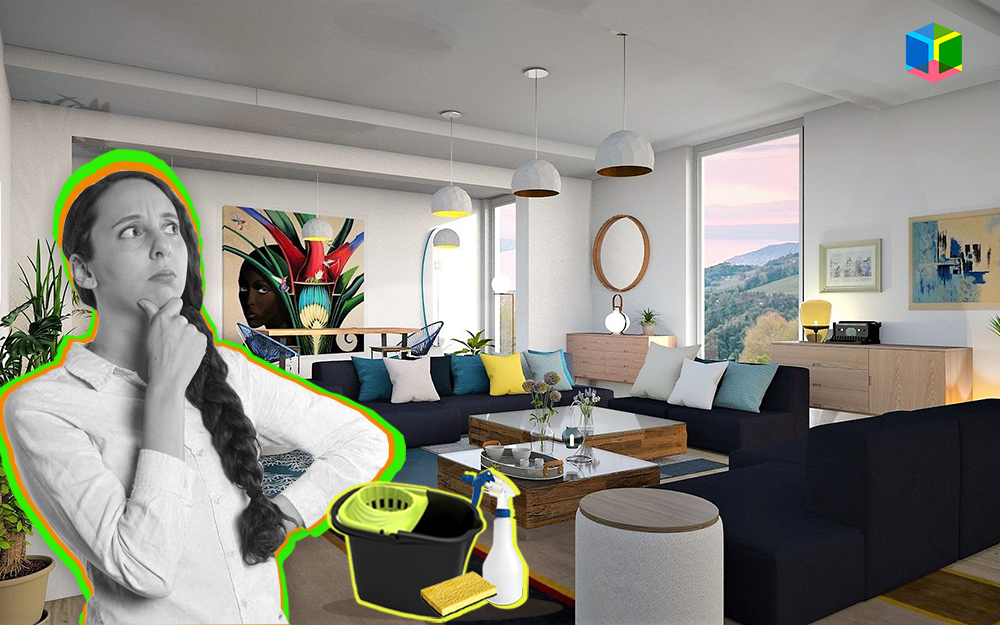
How to disinfect One Of The MOST TOUCHED Surface at home
Share
Is your home-furniture safe from infections and germs?
Keeping your furniture clean and disinfected not only makes it look attractive but also lengthens its durability.
And, furniture being one of the most touched surfaces at home, it is much more relevant to maintain proper sanitary conditions under the current circumstances.
Throughout this blog article, we are going to give you step by step guide on how you can clean and disinfect your:–
- Upholstered Furniture
- Leather Furniture
- Wooden Furniture
- Acrylic and Lucite Furniture
- Plastic Furniture
To keep your home furniture clean and virus-free.
Most household disinfectants are effective on hard surfaces like doorknobs, light switches, counters, tables, handles, desks, toilets, taps, and sinks, whereas using hand-sanitizer, thorough handwashing, proper usage of masks and gloves can ensure personal protection at home.
Besides, while it may seem overwhelming to clean and disinfect a whole house’s worth of furniture, it doesn’t have to be a hassle if done regularly. Let us understand in detail.
How to Clean & Disinfect Upholstered Furniture?

1.Vacuum clean.
Regularly vacuuming your furniture is the first step to keep your furniture clean and disinfecting. Make sure to clean the cracks and crevices of your upholstered furniture between cushions, like the joint areas, the arms of a sofa, and the back. Take the cushions off, to vacuum all sides of them. Give it brushing off first before vacuuming as the majority of dirt and debris can be easily brushed loose thanks to the fiber density and stain-resistant quality.
2. Check the labels.
If you have lost the tag, consult a professional first. Remember, if your furniture needs a solvent-based cleaner, you have to purchase and use that only; but if your furniture is ok with water-based cleaner, you can easily make it at home.
- W is for water-based detergent.
- S stands for Clean with a water-free product, like dry cleaning solvent.
- WS means you may use either a water-based or a water-free cleanser.
- X is for professionally cleaning only, though feel free to vacuum it.
Understand the labels and keep this is in mind when purchasing furniture itself to avoid confusion.
3. Create a water-based cleaner with dish-washing liquid.
Fill a spray bottle with water. Add a couple of drops of dish detergent liquid (not powder), a cap full of white vinegar and a few pinches of baking soda in the mix will combat odor. Shake it well before use.
4. Test the mixture in a hideous spot.
On the back or underside of the upholstery, rub some of the detergent mixtures with the help of a sponge. Wipe it dry with a cloth and then let it air dry completely. Consider cleaning the furniture professionally if discoloration occurs.
Consider using a spray-and-leave Fabric Disinfectant in the end to disinfect the upholstered furniture better.
5. Use a sponge to dampen stains.
With a sponge, rub your mixture into the furniture, and pat it dry with a cloth. Let the detergent sit and penetrate for several minutes on any stains or tough spots in the upholstery.
6. Try to blot future spills.
Avoid extensive cleaning sessions in the future by acting quickly when spills occur, treating them before they stain too severely. As opposed to scrubbing or rubbing, blot the stain to absorb as much liquid as possible before it soaks in.
How to Clean & Disinfect Leather Furniture?

1. Vacuum it first.
While vacuuming, use the soft brush attachment to limit the risk of damaging it. Remove cushions to ensure you reach every nook of the furniture. Regular vacuuming is advised to keep it clean and disinfected.
2. Clean dirt and minor stains with mild dish soap and water.
Take 1 to 2 tablespoons of mild dish detergent with a small bucket of warm water. Dip a clean cloth in the soapy water and wring it out to keep it just damp. Wipe down the dirty areas of your furniture. Finally, pat it dry with a clean cloth. Use a stronger cleaner only if any stain remains.
3. Use vinegar mixture if soapy water doesn’t work.
Mix equal parts vinegar and water in a bucket. Soak a rag in it, wring it out to keep it damp, and wipe down your leather furniture. Rinse out the rag frequently to avoid spreading dirt, and pat it dry after with a clean cloth.
For white or beige furniture, equal parts lemon juice and cream of tartar is an ideal spot cleaner. Just rub the mixture into the stain, and let it sit for 10 minutes. Wipe, if any residue, with a clean cloth.
Rubbing alcohol applied by cotton swab also works wonders for ink stains and mildew. Dry the area with hot air from a blow dryer after cleaning.
4. Nourish the leather furniture with vinegar and linseed oil.
Make a mixture with one part vinegar to two parts linseed oil. Shake it well, rub it, and leave for 10 minutes before you buff it out with a cloth once or more as required. An alternate is to apply leather cream to your furniture after you clean it to re-moisturize the leather. Also, use a leather specific disinfectant spray or oil to keep it disinfected.
5. Avoid cracking and dryness by keeping it out of the sun.
Exposure to direct sunlight is bad for leather, even with great upkeep. Consider keeping them away from open windows, or ensure your curtains are closed when you’re not in the room. Keep leather furniture at least two feet away from heat sources in the home.
How to Clean & Disinfect Wooden Furniture?

1. Understand the finish used on your furniture.
If you’re unsure, begin with a mild cleaner. Then move successively toward stronger cleaning methods depending on the furniture’s reaction (or lack of one). If your furniture is stained, painted, etc., then you should choose a method appropriate to that finish. As a general rule for wood furniture: use the least amount of water, and when you do, remove it from the table at the earliest to avoid warp and crack.
2. Wipe it for dust and loose dirt from the wood.
Use a dry cloth for loosening and removing any dust and dirt on the surface. Avoid feather dusters as their quills can scratch the wood.
3. Use mild soap and water to remove dust and stain.
Mix 1 to 2 tablespoons of mild dish detergent to a small bucket of warm water. Wipe the wood furniture down with the soap-water dampened cloth. Dry the furniture with a clean cloth. If the dirt or stains remain, rub the wood using a rag with mineral spirits. Do it in a well-ventilated space.
4. Make and use a turpentine mixture for use on finished wood.
Mix three-quarters of a cup of boiled linseed oil and one-quarter of a cup of turpentine in a jar, and shake well. Rub the mixture in along the grain and polish with a soft rag. This mixture works very well to increase the gloss and durability of finished wood and to prevent drying and cracking in unfinished wood. Rub the oil thoroughly and allow the furniture to air dry. As an alternative, commercial furniture oil is available for this same purpose. Apart from this, always use a wooden disinfectant spray on a regular basis for disinfecting the wooden furniture.
5. Use furniture wax to protect the furniture if it is unwaxed.
Apply it generously using a cheesecloth, in the direction of the grain. Then, buff with a separate cloth afterward.
How to Clean and Disinfect Acrylic and Lucite Furniture?

1. Use a dry clean cloth to wipe it down.
It requires minimum care. But it can be easily scratched by the little flecks of dirt and grime. Always use a freshly laundered cloth to wipe your furniture down to avoid scratches.
2. Avoid using Windex and glass cleaners.
Cleaners if not designed for acrylic or lucite can crack your furniture. Similarly, if something gets stuck to your furniture, use a wet cloth and specifically designed cleaners only.
3. Remove scratches with plastic polish.
If your furniture has been scratched, it can be repaired with the polish. Apply a small amount of plastic cleaner, and gently buff the area with a soft cloth. Products designed to clean and disinfect plastic are the only cleaners or disinfectants that should be used on acrylic furniture.
How to Clean & Disinfect Plastic Furniture?

1. Wipe it dry.
Use a clean cloth or a dusting brush to wipe out the dust from your plastic furniture. Use vacuum cleaning if required for difficult to reach areas.
2. Use basic soap water to clean it.
Make soap detergent at home with few drops of dishwashing liquid in a bucket of water. Use a cloth dampened in it and rub the surfaces well to clean it properly. As an alternate, you may opt for a ready to use plastic cleaner.
3. Pat it dry with a clean cloth.
After washing it well, use a clean cloth to pat it dry.
4. Spray it up with disinfectant sanitizer.
You may additionally use sanitizer/disinfectant spray frequently to keep it clean and disinfected.
Before and After Hygiene:
Make sure to use a proper face mask and eye protection while cleaning. Use gloves to avoid any touch of chemicals directly.
After Cleaning and Disinfecting the furniture, remove the mask and eye protection, dispose of the gloves or put it separate for washing if it is reusable.
Once the gloves, mask, and eye protection are taken down, always wash your hands thoroughly with a mild hand washing liquid or soap for at least 20 seconds. And, if you have been doing the dry cleaning only, you may opt to use a hand sanitizer afterward with at least 60% alcohol density.
We hope that it is informative and it will help you understand and choose the most appropriate way to clean and disinfect your home furniture without being overwhelmed, regardless of the type and material it is, like a pro.
Please do share your ideas and thoughts about how you clean and maintain hygiene of your home furniture.
Also, if you find this article worth a read, feel free to share it with your dear ones.






